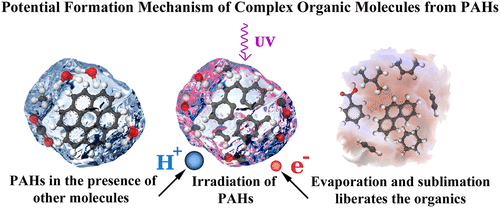当前位置:
X-MOL 学术
›
ACS Earth Space Chem.
›
论文详情
Our official English website, www.x-mol.net, welcomes your
feedback! (Note: you will need to create a separate account there.)
Formation of Complex Organic Molecules (COMs) from Polycyclic Aromatic Hydrocarbons (PAHs): Implications for ISM IR Emission Plateaus and Solar System Organics
ACS Earth and Space Chemistry ( IF 2.9 ) Pub Date : 2020-11-20 , DOI: 10.1021/acsearthspacechem.0c00165 Andrew L. Mattioda 1 , Gustavo A. Cruz-Diaz 1, 2 , Andrew Ging 1 , Michael Barnhardt 1 , Christiaan Boersma 1, 3 , Louis J. Allamandola 1, 2 , Todd Schneider 4 , Jason Vaughn 4 , Brandon Phillips 4 , Alessandra Ricca 1, 5
ACS Earth and Space Chemistry ( IF 2.9 ) Pub Date : 2020-11-20 , DOI: 10.1021/acsearthspacechem.0c00165 Andrew L. Mattioda 1 , Gustavo A. Cruz-Diaz 1, 2 , Andrew Ging 1 , Michael Barnhardt 1 , Christiaan Boersma 1, 3 , Louis J. Allamandola 1, 2 , Todd Schneider 4 , Jason Vaughn 4 , Brandon Phillips 4 , Alessandra Ricca 1, 5
Affiliation

|
The presence of complex organic molecules (COMs) in a variety of solar system objects has prompted various theories regarding their origins. This paper reports on a series of proton, electron, and UV radiation experiments, conducted singly and in combination, on polycyclic aromatic hydrocarbon (PAH) thin films to determine if PAH-related materials could be related to COMs. Fourier transform infrared (FTIR) and mass spectra reveal that the PAHs are fragmented and altered, producing new infrared features and a mass spectral pattern similar to those from small aliphatic and larger saturated hydrocarbon chain and ring systems. Mass spectra after proton and electron irradiation exhibit significant differences. The proton irradiation products appear to contain more oxygen-related species, possibly the result of higher H2O concentrations in the vacuum chamber, whereas electron irradiation generates a more abundant, larger mass organic species mass spectral pattern. Combined irradiation produces a superposition of the proton and electron results, with some subtle differences. Mass spectral patterns resulting from electron and combined irradiation compare favorably to Cassini ion neutral mass spectrometer (INMS) measurements of particles falling from Saturn’s inner rings into its upper atmosphere. FTIR results are compared to PAH emission from interstellar sources and absorption components in IR spectra observed toward low-mass young stellar objects (YSOs). Notably, some newly reported broad IR features appear very similar in structure to the plateaus underlying the astronomical 3.2−3.6, 6−9, and 10–15 μm emission plateaus and several of the absorption components found in spectra observed toward YSOs. The studies also indicate that the presence of other species, such as H2O, may significantly impact the radiation products. These results point to the fact that a top-down synthesis of solar system COMs is possible via irradiative processing of PAHs.
中文翻译:

由多环芳烃(PAHs)形成复杂有机分子(COMs):对ISM IR发射平台和太阳系有机物的影响
各种太阳系物体中复杂有机分子(COMs)的存在催生了有关其起源的各种理论。本文报道了在多环芳烃(PAH)薄膜上单独或组合进行的一系列质子,电子和紫外线辐射实验,以确定PAH相关材料是否可能与COM相关。傅立叶变换红外(FTIR)和质谱表明,多环芳烃被碎片化和改变,产生了新的红外特征,并且质谱图与来自小的脂肪族和较大的饱和烃链和环系统的特征相似。质子和电子辐照后的质谱显示出显着差异。质子辐照产物似乎包含更多与氧有关的物质,这可能是由于H 2含量较高的结果O浓度在真空室中,而电子辐照会产生更丰富,质量更大的有机物种质谱图。联合照射产生质子和电子结果的叠加,但有一些细微的差异。由电子和组合辐射产生的质谱图与卡西尼离子中性质谱仪(INMS)对从土星内环落入其高层大气的颗粒的测量结果相比具有优势。将FTIR结果与星际源的PAH发射以及红外光谱中向低质量的年轻恒星物体(YSOs)观察到的吸收成分进行了比较。值得注意的是,一些新近报道的宽红外特征看上去在结构上与天文3.2-3.6、6-9,在YSOs的光谱中发现了10–15μm的发射平台和一些吸收成分。研究还表明存在其他物种,例如H2 O,可能会严重影响辐射产物。这些结果表明,通过对PAHs进行辐照处理,可以自上而下地合成太阳系COM。
更新日期:2020-12-17
中文翻译:

由多环芳烃(PAHs)形成复杂有机分子(COMs):对ISM IR发射平台和太阳系有机物的影响
各种太阳系物体中复杂有机分子(COMs)的存在催生了有关其起源的各种理论。本文报道了在多环芳烃(PAH)薄膜上单独或组合进行的一系列质子,电子和紫外线辐射实验,以确定PAH相关材料是否可能与COM相关。傅立叶变换红外(FTIR)和质谱表明,多环芳烃被碎片化和改变,产生了新的红外特征,并且质谱图与来自小的脂肪族和较大的饱和烃链和环系统的特征相似。质子和电子辐照后的质谱显示出显着差异。质子辐照产物似乎包含更多与氧有关的物质,这可能是由于H 2含量较高的结果O浓度在真空室中,而电子辐照会产生更丰富,质量更大的有机物种质谱图。联合照射产生质子和电子结果的叠加,但有一些细微的差异。由电子和组合辐射产生的质谱图与卡西尼离子中性质谱仪(INMS)对从土星内环落入其高层大气的颗粒的测量结果相比具有优势。将FTIR结果与星际源的PAH发射以及红外光谱中向低质量的年轻恒星物体(YSOs)观察到的吸收成分进行了比较。值得注意的是,一些新近报道的宽红外特征看上去在结构上与天文3.2-3.6、6-9,在YSOs的光谱中发现了10–15μm的发射平台和一些吸收成分。研究还表明存在其他物种,例如H2 O,可能会严重影响辐射产物。这些结果表明,通过对PAHs进行辐照处理,可以自上而下地合成太阳系COM。











































 京公网安备 11010802027423号
京公网安备 11010802027423号